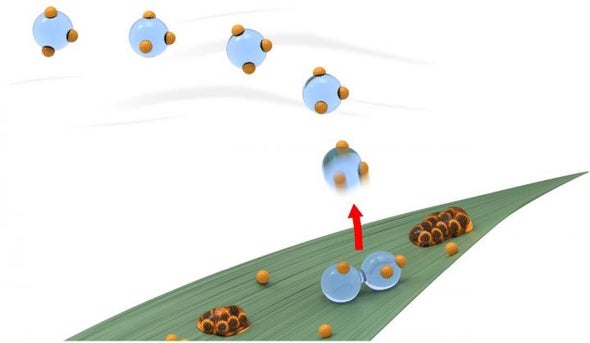(单词翻译:单击)
听力文本
This is Scientific American's 60-second Science, I'm Christopher Intagliata.
Humans can spread disease by sneezing. But less well known is the wheat plant's ability to do something strangely similar—from its leaves.
"It's basically analogous to a human sneeze in terms of, you have a very fast and sudden expulsion of droplets that contain the disease or pathogen inside of it, and they get thrown away from the surface."
Jonathan Boreyko, a mechanical engineer at Virginia Tech. He and his team were studying the ability of wheat plants to expel spores of a common pathogen, the wheat rust fungus, from their leaves via this unusual mechanism. So they inoculated wheat plants with the disease, created dew on the plants' leaves and then studied the ensuing action with high-speed microscopy.

Here's what they saw. The leaves are extremely hydrophobic, meaning water beads up to minimize contact with the surface. And when two or more drops touch, energy gets released in the form of a catapulting action, which "sneezes" the droplets into the air several millimeters above the leaf surface. The droplets can then be picked up by light breezes or simply fall and spread to other plants. The process is surprisingly effective at launching spores: the researchers figure each leaf can launch 100 spores per hour during a morning dew.
The results—and photos of the jumping drops—are in the Journal of the Royal Society Interface.
Next, Boreyko and his team want to see what happens if they spray stuff on the leaves that changes the way dew forms. "If we change the wettability of the leaves so they're no longer super hydrophobic, now the dew drops will be unable to jump when they grow. They'll just sort of cling to the leaf surface and not be jumping anymore."
Such treatment could perhaps put a stop to wheat sneezes and slow down the transmission of disease.
Thanks for listening for Scientific American — 60-Second Science. I'm Christopher Intagliata.
参考译文
这里是科学美国人——60秒科学系列,我是克里斯托弗·因塔格里塔。
人类可以通过打喷嚏传播疾病。但鲜为人知的是,小麦植物的叶子也有能力做一些极其类似的事情。
“这基本上与人类打喷嚏类似,非常迅速且突然地喷出含有疾病或病原体的液滴,这些液滴是从叶子表面被抛出的。”
乔纳森·博瑞科是弗吉尼亚理工大学的机械工程师。他和团队正在研究小麦植株通过这种不同寻常的机制,将常见病菌小麦锈菌从叶片上排出的能力。因此,他们给小麦植株接种这种病菌,使植株的叶子上产生露水,然后用高速显微镜研究之后的行动。
以下是他们观察到的情况。叶片极其疏水,这意味着上面的水会形成水珠,尽量减少与叶面的接触。当两滴及两滴以上的水珠接触时,能量以弹射形式被释放,弹射动作将水滴“喷”到叶面上方几毫米处的空气中。之后,水滴可能会被微风带走,也可能直接落下,扩散到其它植物上。这个过程在发射孢子方面出奇地有效:研究人员认为,晨露期间,每片叶子每小时可发射100个孢子。
研究结果和跳跃水滴的照片发表在《英国皇家学会会刊》上。
接下来,博瑞科和团队想知道,如果他们在叶子上喷洒能改变露水形成方式的物质,会发生什么。“如果我们改变叶子的湿润性,让它们不再超级疏水,那露珠在形成时就无法跳跃。它们只会粘在叶面上,不再跳跃。”
这种处理方式也许可以阻止小麦打喷嚏,减缓疾病的传播。
谢谢大家收听科学美国人——60秒科学。我是克里斯托弗·因塔利亚塔。
译文为可可英语翻译,未经授权请勿转载!
重点讲解
重点讲解:
1. be analogous to 相似的;类似的;可比拟的;
The gills of fishes are analogous to the lungs in terrestrial animals.
鱼类的鳃与陆上动物的肺类似。
2. cling to 黏附;粘住;
Her glass had bits of orange clinging to the rim.
她的杯口上粘有些许橙汁。
3. put a stop to 制止;阻止;
His daughter should have stood up and put a stop to all these rumours.
他的女儿早该站出来平息所有这些谣言。
4. slow down (使)放慢;(使)减速;
There is no cure for the disease, although drugs can slow down its rate of development.
尽管药物可以减缓病情的发展,但是这种病仍然是不治之症。


